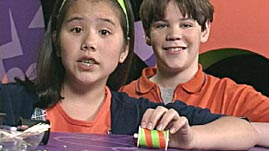Teachers' Domain - Digital Media for the Classroom and Professional Development
User: Preview


Source: ZOOM
Potential and Kinetic Energy: Spool Racer (Audio Description) (Video)
Potential and Kinetic Energy: Spool Racer (Document)
KEIKO: Eleanor M. of Philadelphia, Pennsylvania sent us these instructions to build a spool racer. All you need are some spools, toothpicks, pencils, metal washers, rubber bands and tape. The first thing you have to do is put a rubber band through the middle of your spool. What I do is put the rubber band on a toothpick, like this.
MIKE: Did you still have it on the other side? All right, good, cool.
KEIKO: Now... and on the other end... you put a pencil.
MIKE: There you go.
KEIKO: That's kind of loose, so you probably should double it, maybe.
MIKE: Yeah, wrap it around the pencil twice.
KEIKO: So, we'll just put this on like this.
MIKE: Yep. Now, to get your spool racer to go faster, you snap off the ends of your toothpick, so it's right... even with the ends of the spool like that. Okay, then you have to tape it down so it'll be sturdy.
KEIKO: There you go.
MIKE: Okay. Now, you hold the rubber band on one side and take out the pencil, because you have to put a washer on now so it'll go more smooth. Grab the pencil... and put it back in. And...
KEIKO: …double it. (laughs)
MIKE: Want to do the honors?
KEIKO: Okay. Now you just wind it up...
MIKE: …until it comes back to you.
KEIKO: Yay!
MIKE: All right, here we go. Let's see how this baby works.
KEIKO: Go! It's not going...
MIKE: Oh, wait. Maybe it's too far up now. There we go!
KEIKO: There we go!
MIKE: All right, you want to race now?
KEIKO: Sure.
MIKE: I got one ready. Welcome to the ZOOM 500.
KEIKO: Wait, how do I know if I overwound it?
MIKE: You don't. All right, ready?
KEIKO: Okay.
MIKE: You get to say "Go ahead."
KEIKO: Ready... Set... Go!
MIKE: Oh, no!
 Loading Standards
Loading Standards Teachers' Domain is proud to be a Pathways portal to the National Science Digital Library.
Teachers' Domain is proud to be a Pathways portal to the National Science Digital Library.
